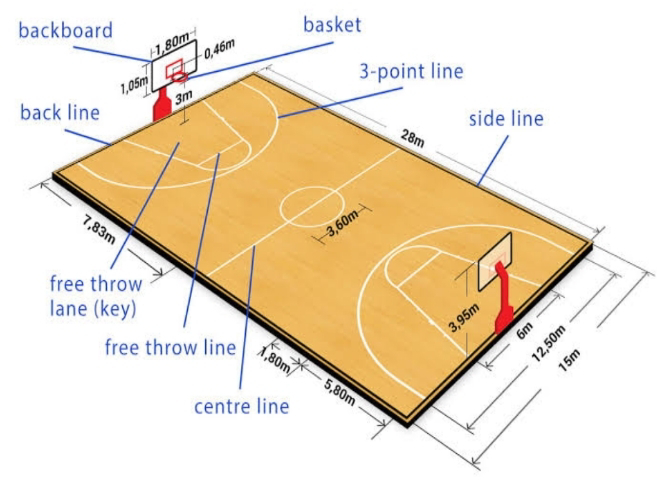In the captivating world of basketball, where fast breaks, slam dunks, and three-pointers unfold, the basketball court is the sacred ground where the magic happens. As fans, we often marvel at the athleticism and strategy displayed by players, but how often do we pause to consider the very stage that sets the scene for these exhilarating moments? The dimensions of a basketball court are more than just measurements; they are the blueprint for the ebb and flow of the game. In this exploration, we will peel back the layers and delve into the intricate details that define the dimensions of a basketball court, unlocking the secrets behind the lines and boundaries that shape this beloved sport. Welcome to the world where precision meets play—the dynamic realm of basketball court dimensions.
The Standard Dimensions:
Now that we've stepped onto the hardwood, let's take a closer look at the standardized dimensions that serve as the architectural backbone of every basketball court. These dimensions, meticulously defined by international and professional governing bodies, ensure a consistent and fair playing field across the globe.
(1) Length and Width:
The length of a standard basketball court is Ninety four feet (28.65 meters). This expansive stretch of hardwood provides ample room for players to showcase their speed, agility, and tactical prowess.
The width measures 50 feet (15.24 meters), creating a symmetrical and balanced playing surface where offense and defense engage in a dynamic dance.
(2) Basket Height:
The iconic basketball hoop, suspended 10 feet (3.05 meters) above the court, stands as a universal challenge for players aiming to score. This unchanging height adds an element of consistency to the game, regardless of the level of play.
(3) Free-Throw Line:
Positioned 15 feet (4.57 meters) away from the backboard, the free-throw line is a stripe of opportunity. It is from this spot that players must showcase their shooting accuracy, free from the pressures of defensive interference.
(4) Three-Point Line:
The three-point line, a symbol of long-range marksmanship, varies slightly across leagues. In the NBA, the arc extends 23.75 feet (7.24 meters) at the top of the key and 22 feet (6.70 meters) in the corners. Beyond this line, a successful shot is worth three points, adding a strategic layer to the game.
(5) Key (Paint) Area:
Often referred to as "the paint" or "the key," this rectangular area is 16 feet (4.88 meters) wide in both the NBA and FIBA regulations. The keyhole, extending 19 feet (5.80 meters) from the baseline, is a critical zone where interior battles unfold—big men jostling for position, defenders protecting the rim, and agile players maneuvering through traffic.
Understanding the Significance:
The standardized dimensions of a basketball court are not arbitrary; they are the architectural framework that breathes life into the game. Every line, every measurement, and every boundary holds profound significance, shaping the way the sport is played and experienced. Let's unravel the layers of significance embedded in these court dimensions:
(1) Speed and Transition:
The length of the court, set at 94 feet (28.65 meters), dictates the pace of the game. A longer court allows for fast breaks and rapid transitions from defense to offense. Teams with adept ball handlers and swift players can exploit the length, creating thrilling moments of end-to-end action.
(2) Shooting Challenges:
The three-point line, a defining feature of modern basketball, challenges players to showcase their shooting accuracy from beyond the arc. In the NBA, the arc is strategically placed at varying distances, encouraging teams to develop sharpshooters capable of sinking long-range shots. This dynamic element adds excitement and unpredictability to the game.
(3) Interior Battles:
The key area, or "the paint," is where interior battles unfold. The 16-foot (4.88 meters) width of the key provides a confined space where big men showcase their strength, positioning, and rebounding skills. This area is a strategic battleground, and players must navigate the paint with finesse to score or defend effectively.
(4) Strategic Zones:
The positioning of the free-throw line and the three-point line creates strategic zones on the court. Teams leverage these zones to devise offensive plays and defensive strategies. Players must master the art of free-throw shooting, and three-point specialists become valuable assets, altering the course of a game with their long-range prowess.
(5) Consistency Across Levels:
The standardized dimensions ensure consistency across different levels of play, from local community courts to international arenas. Whether it's a pickup game at a neighborhood court or a high-stakes playoff match in a professional league, the players are presented with the same court dimensions, promoting fairness and equal opportunity.
(6) Teamwork and Spatial Awareness:
The dimensions of the court demand exceptional teamwork and spatial awareness. Players must understand the court's layout to execute plays effectively, utilizing the available space for strategic advantages. Coaches emphasize court awareness, positioning, and movement to maximize their team's efficiency within these dimensions.
Conclusion:
In the realm of basketball, where every dribble, pass, and shot unfolds on the carefully measured canvas of the court, the significance of dimensions becomes undeniably clear. As we conclude our exploration into the standardized measurements that shape this beloved sport, we recognize that these boundaries are more than lines on the floor—they are the dynamic parameters within which the drama of the game comes to life.
The basketball court dimensions serve as the silent architects of the sport, influencing the strategies devised by coaches, the skill sets honed by players, and the sheer spectacle witnessed by fans worldwide. From the thunderous dunks launched from the free-throw line to the precision of three-point shooters navigating the arc, every inch of the court plays a role in defining the narrative of a basketball game.
The elongated length challenges the limits of speed and endurance, inviting players to push their physical boundaries. The three-point line, with its strategic placement, transforms the court into a strategic battlefield where shooters aim to secure an extra point for their team. Meanwhile, the key area remains a crucible for interior battles, where strength, agility, and finesse determine success.
In the world of basketball, dimensions are not constraints; they are opportunities. They provide the stage upon which the unpredictable, the awe-inspiring, and the extraordinary unfold. As fans, we are not merely witnesses to a game; we are participants in the synergy between precision and play, where every inch matters and every strategic move is calculated within the parameters of the court.
So, as the echoes of sneakers squeaking on hardwood fade and the final buzzer sounds, we are left with a profound appreciation for the intricacies of basketball court dimensions. They are the silent orchestrators of a sport that transcends borders and unites fans in the universal language of competition and camaraderie. Whether played on a neighborhood court or under the bright lights of a professional arena, the dimensions of a basketball court are the unspoken storytellers of a game that continues to captivate hearts around the world. As we celebrate the dimensions, we celebrate the very essence of basketball—a sport where precision meets play, and the magic unfolds within the carefully measured boundaries of the court.
More News:
Hockey Field Dimensions and Measurements




No comments:
Post a Comment